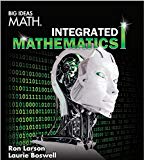
Concept explainers
(a)
To justify: the number of hours the total costs will be same
(a)
Answer to Problem 14CT
The total costs will be same for
Explanation of Solution
Given:
| Cost of parts | Labor cost per hour | |
| Dealership | $24 | $99 |
| Local mechanic | $45 | $89 |
Calculation:
Find when the costs are equal:
Define a variable.
Write an equation.
Subtract
Subtract 24 from both sides.
Divide both sides by 10.
Conclusion:
The total costs will be same for
(b)
To find: where will the cost be cheaper.
(b)
Answer to Problem 14CT
When the number of hours is more than 2.1, it is cheaper at the local mechanic.
Explanation of Solution
Calculation:
When the number of hours is more than 2.1, it is cheaper at the local mechanic. When the number of hours is less than 2.1, it is cheaper at the dealership.
Conclusion:
When the number of hours is more than 2.1, it is cheaper at the local mechanic.
Chapter 1 Solutions
BIG IDEAS MATH Integrated Math 1: Student Edition 2016
- Saved Tempo Company's fixed budget (based on sales of 18,000 units) folllows Fixed Budget Sales (18,000 units x $201 per unit) 3,618,000 Costs Direct materials Direct labor Indirect materials Supervisor salary 432,000 792,000 486,000 232,000 Sales commissions 126,000 Shipping 270,000 Administrative salaries 232,000 Depreciation-office equipment 252,000 Insurance 222,000 Office rent 232,000 Income 292,000 1. Compute total variable cost per unit. 2. Compute total fixed costs 3. Prepare a flexible budget at activity levels of 16,000 units and 20,000 units. Complete this question by entering your answers in the tabs below. Q Search hp PRES 0 Oarrow_forwardy=x-9 y= 2x+4arrow_forward7) 8) Let R be the region bounded by the given curves as shown in the figure. If the line x = k divides R into two regions of equal area, find the value of k 7. y = 3√x, y = √x and x = 4 8. y = -2, y = 3, x = −3, and x = −1 -1 2 +1 R Rarrow_forward
- L sin 2x (1+ cos 3x) dx 59arrow_forwardConvert 101101₂ to base 10arrow_forwardDefinition: A topology on a set X is a collection T of subsets of X having the following properties. (1) Both the empty set and X itself are elements of T. (2) The union of an arbitrary collection of elements of T is an element of T. (3) The intersection of a finite number of elements of T is an element of T. A set X with a specified topology T is called a topological space. The subsets of X that are members of are called the open sets of the topological space.arrow_forward
- 2) Prove that for all integers n > 1. dn 1 (2n)! 1 = dxn 1 - Ꮖ 4 n! (1-x)+/arrow_forwardDefinition: A topology on a set X is a collection T of subsets of X having the following properties. (1) Both the empty set and X itself are elements of T. (2) The union of an arbitrary collection of elements of T is an element of T. (3) The intersection of a finite number of elements of T is an element of T. A set X with a specified topology T is called a topological space. The subsets of X that are members of are called the open sets of the topological space.arrow_forwardDefinition: A topology on a set X is a collection T of subsets of X having the following properties. (1) Both the empty set and X itself are elements of T. (2) The union of an arbitrary collection of elements of T is an element of T. (3) The intersection of a finite number of elements of T is an element of T. A set X with a specified topology T is called a topological space. The subsets of X that are members of are called the open sets of the topological space.arrow_forward
- 3) Let a1, a2, and a3 be arbitrary real numbers, and define an = 3an 13an-2 + An−3 for all integers n ≥ 4. Prove that an = 1 - - - - - 1 - - (n − 1)(n − 2)a3 − (n − 1)(n − 3)a2 + = (n − 2)(n − 3)aı for all integers n > 1.arrow_forwardDefinition: A topology on a set X is a collection T of subsets of X having the following properties. (1) Both the empty set and X itself are elements of T. (2) The union of an arbitrary collection of elements of T is an element of T. (3) The intersection of a finite number of elements of T is an element of T. A set X with a specified topology T is called a topological space. The subsets of X that are members of are called the open sets of the topological space.arrow_forwardDefinition: A topology on a set X is a collection T of subsets of X having the following properties. (1) Both the empty set and X itself are elements of T. (2) The union of an arbitrary collection of elements of T is an element of T. (3) The intersection of a finite number of elements of T is an element of T. A set X with a specified topology T is called a topological space. The subsets of X that are members of are called the open sets of the topological space.arrow_forward
 Discrete Mathematics and Its Applications ( 8th I...MathISBN:9781259676512Author:Kenneth H RosenPublisher:McGraw-Hill Education
Discrete Mathematics and Its Applications ( 8th I...MathISBN:9781259676512Author:Kenneth H RosenPublisher:McGraw-Hill Education Mathematics for Elementary Teachers with Activiti...MathISBN:9780134392790Author:Beckmann, SybillaPublisher:PEARSON
Mathematics for Elementary Teachers with Activiti...MathISBN:9780134392790Author:Beckmann, SybillaPublisher:PEARSON
 Thinking Mathematically (7th Edition)MathISBN:9780134683713Author:Robert F. BlitzerPublisher:PEARSON
Thinking Mathematically (7th Edition)MathISBN:9780134683713Author:Robert F. BlitzerPublisher:PEARSON Discrete Mathematics With ApplicationsMathISBN:9781337694193Author:EPP, Susanna S.Publisher:Cengage Learning,
Discrete Mathematics With ApplicationsMathISBN:9781337694193Author:EPP, Susanna S.Publisher:Cengage Learning, Pathways To Math Literacy (looseleaf)MathISBN:9781259985607Author:David Sobecki Professor, Brian A. MercerPublisher:McGraw-Hill Education
Pathways To Math Literacy (looseleaf)MathISBN:9781259985607Author:David Sobecki Professor, Brian A. MercerPublisher:McGraw-Hill Education





